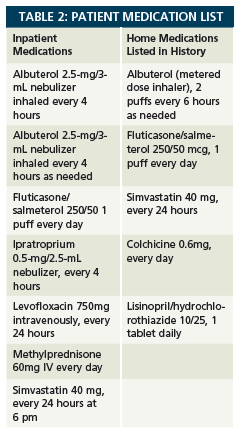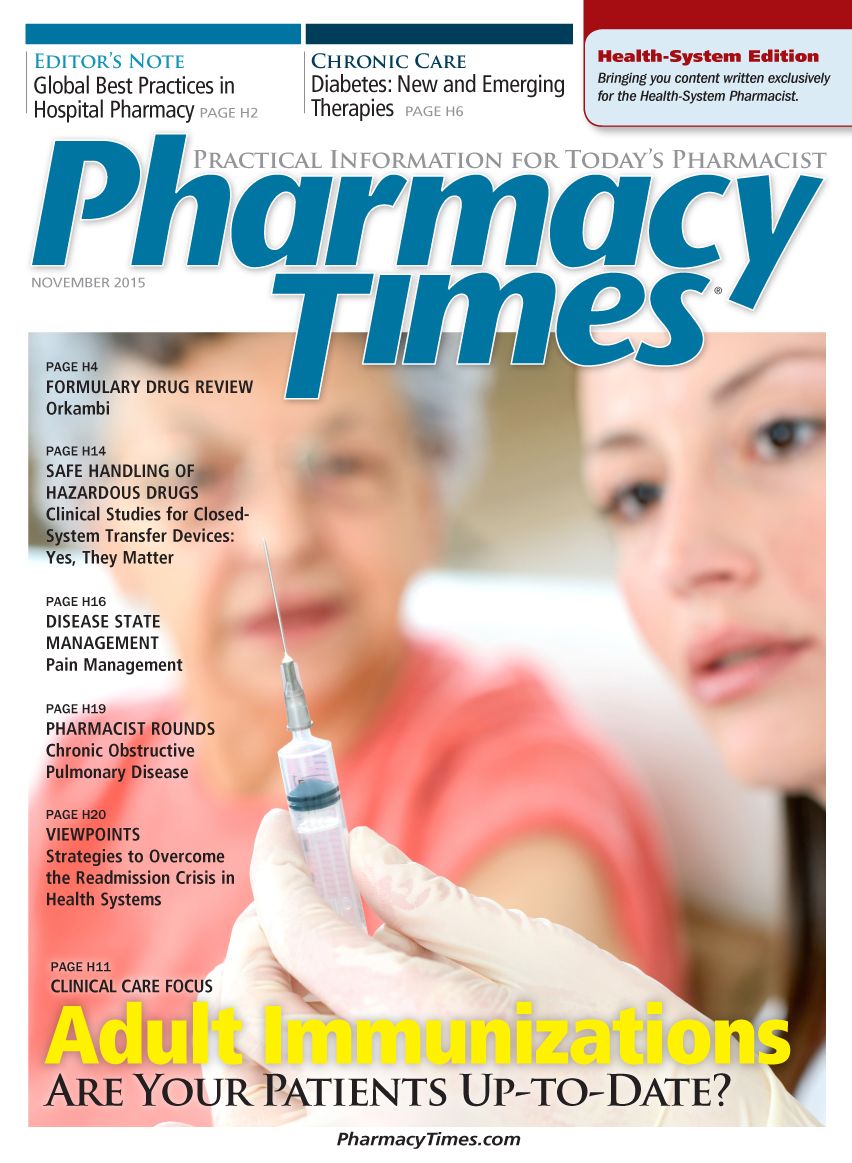Chronic Obstructive Pulmonary Disease
How should you treat this patient?

Case
A 48-year-old man was admitted overnight to the hospital complaining of increasing shortness of breath, increase in yellow-green sputum, chest pain, low-grade fever, dysphagia, and weight loss. The patient has already had 2 episodes of bronchitis this year and his medical history includes hypertension, smoking (40 pack-years), presumed chronic obstructive pulmonary disease (COPD), and gout. His chest x-ray showed infiltrate consistent with infection. Sputum gram stain culture is pending. For laboratory results, see Online Table 1. For patient medication history, see Table 2.
Online Table 1: Patient Laboratory Results
- Laboratory results at admission: 1800: complete blood count (CBC) 12> 13.6/41.7<283; chemistry panel: 131/4.9-106/32-9/1.2 <185.
- Next morning laboratory results: CBC 17>13.1/40<285; chemistry panel: 132/4.8-105/32-16/1.4< 165.
Answer
After reviewing the profile and the patient’s interview, the following stand out as potential pharmacy interventions:
(1) Antibiotic—Evaluate whether an antibiotic is needed (changes in sputum purulence or color, sputum gram stain/culture, fever, chest x-ray, etc).
- Levofloxacin 750 mg every day is a good choice for inpatient care. If previous exacerbations involved hospitalization/intubation, risk for pseudomonas or resistant organisms increases (see Online Table 3). Consider change to oral levofloxacin.
- Ceftriaxone and azithromycin or doxycycline (alternative inpatient therapy).
- For mild exacerbation, doxycycline 100 mg twice daily or amoxicillin/ clavulanic 875 mg twice a day may be appropriate alternatives.
(2) Steroid—Change methylprednisolone to prednisone 40 mg orally every day for 5 days. Consider longer steroid duration (ie, taper over 2 weeks) if last exacerbation was recent or if the patient is slow to improve.
(3) Renal function:
- Creatinine increased since admission may be upward trend.
- Consider holding colchicine and hydrochlorothiazide.
- Adjust doses of medications if needed.
(4) White blood cells—Increase most likely due to prednisone.
(5) Inhalation therapy:
- For acute inpatient: Albuterol 0.83% (2.5 mg/3 mL) nebulizer every 4 hours. Ipratroprium (0.5 mg/2.5 mL) nebulizer every 6 hours (frequency change). Address the use of both long-acting beta-2-agonists and inhaled corticosteroids with scheduled albuterol every 4 hours.
- Consider stopping use of the combination product and use budesonide and albuterol nebulized until patient stabilizes. Address the frequency of fluticasone/ salmeterol; dose is typically twice a day. Review inhaler technique with patient. Reevaluate use of fluticasone/salmeterol long term (address as outpatient). Consider long-acting anticholinergic (eg, tiotroprium, acalidium).
(6) Smoking:
- Although the patient declined medications for inpatient management, provide cessation materials and phone numbers for future reference. Encourage small changes until the time is right to fully commit to quitting (ie, decrease number of cigarettes per day).
(7) Diagnostics—If pulmonary function test results are not provided, obtain for diagnosis/staging of COPD after exacerbation is resolved.
(8) Vaccines—Up-to-date on influenza, pneumococcal vaccination.
Would you like to submit a case study to the Pharmacy Times Health-System Edition? Please contact Stephen F. Eckel, PharmD, MHA, BSPS, FASHP, FAPhA, at SEckel@unch.unc.edu.
Jennifer Barrow, PharmD, is a clinical specialist in adult medicine at the University of North Carolina.
Resources
- Gold Guidelines. www.goldcopd.org. Accessed June 2015.
- Leuppi JD, Scheutz P, Bingisser R, et al. Short-term vs conventional glucocorticoid therapy in acute exacerbation of chronic obstructive pulmonary disease: the REDUCE randomized clinical trial. JAMA. 2013;309(21):2223-2231. doi: 10.1001/jama.2013.5023.
- Vollenweider DJ, Jarrett H, Steurer-Stey CA, Garcia-Aymerich J, Puhan MA. Antibiotics for exacerbations of chronic obstructive pulmonary disease. Cochrane Database Syst Rev. 2012;12:CD010257 doi: 10.1002/14651858.CD010257.
- Miravitlles M, Moragas A, Hernandez S, Bayona C, Llor C. Is it possible to identify exacerbations of mild to moderate COPD that do not require antibiotic treatment? Chest. 2013;144(5):1571-1577. doi: 10.1378/chest.13-0518.
- Papi A, Haughney J, Virchow JC, Roche N, Palkonen S, Price D. Inhaler devices for asthma: a call for action in a neglected field. Eur Respir J. 2011:37(5): 982-985. doi: 10.1183/09031936.00150910.
- Short PM, Williamson PA, Elder DH, Lipworth SI, Schembri S, Lipworth BJ. The impact of tiotroprium on mortality and exacerbations when added to inhaled corticosteroids and long-acting beta-agonist therapy in COPD. Chest. 2012:141(1):81-86. doi: 10.1378/chest.11-0038.
- Kunz LI, Postma DS, Klooster K, Lapperre TS, Vonk JM, et al; GLUCOLD Study Group. Relapse in FEV1 decline after steroid withdrawal in COPD. Chest. 2015;148(2):389-396. doi: 10.1378/chest.14-3091.
- D’Urzo A, Donohue JF, Dardose P, Miravitles M, Price D. A re-evaluation of the role of inhaled corticosteroids in the management of patients with chronic obstructive pulmonary disease. Expert Opin Pharmacother. 2015;16(12):1845-1860. doi: 10.1517/14656566.2015.1067682.

